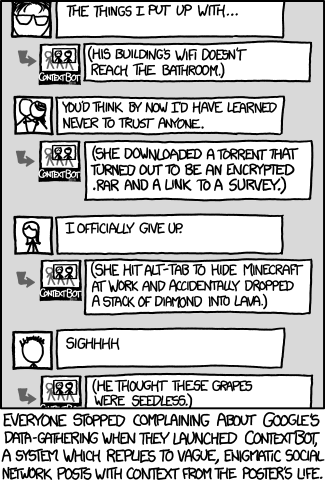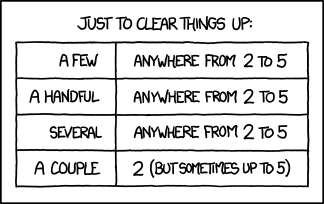Danil Zburivsky
Shared posts
Nothing but words to learn to lie/Aoi Kotsuhiroi
DTracing in Anger
Danil ZburivskyМаки для дизайнеров!
My Macbook has becomeso sluggish that it feels like I’m typing ove a 9600 baud modem aagn. Or 2400. It’s alo droping keystokes – which is irritatng as hll – so please forgive theapparent tyos and mistakes. It comes and goes each minute, so thiswhole post isn’t too bad.
Usually I cn see what’s wrng using my Top 10 DTrace scripts for Mac OS X, which have a focus on disk and file system issues. That’s not the casehere.
Since this isinterferig wth localapplications, specifically, my keystokes as I type in vim, my suspects are CPU related. top(1) and DTrace profiling tells me this running:
# dtrace -n 'profile-99 { @[execname] = count(); } tick-1s { trunc(@, 5); printa(@); trunc(@); }'
dtrace: description 'profile-99 ' matched 2 probes
CPU ID FUNCTION:NAME
4 16339 :tick-1s
configd 39
firefox 46
Google Chrome H 55
SystemUIServer 96 ← who r u??
kernel_task 444
Ok, so lets start with SystemUIServer, although I have no idea what it is, and there is no man page. A quick Internet search tells me it manages menu bar popups, and device removal (CDROMs, DVDs, USB). Suggestions include:
- reboot
- logout and log back in
- run killall SystemUIServer to kill it, and allow it to restart automatically.
- use command-R at startup and reinstall Lion OS X. “Everything solved.”
That doesn’t sound scientific. The only suggested root-cause I saw wasthat it had a “memory leak”.
Lets look using DTrace.
First is to profile the on-CPU usage:
# dtrace -n 'profile-97 /execname == "SystemUIServer"/ { @[ustack()] = count(); }'
dtrace: description 'profile-97 ' matched 1 probe
dtrace: error on enabled probe ID 1 (ID 28: profile:::profile-97): invalid address (0x118ca2f00) in action #2
dtrace: error on enabled probe ID 1 (ID 28: profile:::profile-97): invalid address (0x7fff50b4b1f0) in action #2
dtrace: error on enabled probe ID 1 (ID 28: profile:::profile-97): invalid address (0x7fff50b4a130) in action #2
dtrace: error on enabled probe ID 1 (ID 28: profile:::profile-97): invalid address (0x7fff50b4afc0) in action #2
[...]
Ow. This was supposed to sample on-CPU user-level stacks, but I’ve hit the profiling stack-trace bug currently present on Mac OS X. Once this is fixed, this will be a lot easier to debug, as I can quickly roll Flame Graphs.
Now you get to see how I work around this on Mac OS X.
One level of stack works:
# dtrace -n 'profile-97 /execname == "SystemUIServer"/ { @[ustack(1)] = count(); }'
dtrace: description 'profile-97 ' matched 1 probe
^C
[...]
CoreFoundation`CFRelease+0x46
9
libsystem_kernel.dylib`__workq_kernreturn+0xa
10
libobjc.A.dylib`objc::DenseMap, objc::DenseMapInfo >::LookupBucketFor(objc_object* const&, std::__1::pair*&) const+0x3a
11
libsystem_c.dylib`OSAtomicCompareAndSwap64Barrier$VARIANT$mp+0x8
12
libsystem_kernel.dylib`kevent+0xa
26
libsystem_kernel.dylib`mach_msg_trap+0xa
151
This tells me mach_msg_trap() was on-CPU more than anyone else. Really wish I could see the full sttack trace, but can’t with profiling due to that bug.
I can with the pid provider. This will begin to slow the target due to the ovrheads of pid tracing and user-level stack collection, but given how woefully slow this laptop is already, I don’t mind.
# dtrace -n 'pid$target::mach_msg_trap:entry { @[ustack()] = count(); }' -p 177
dtrace: description 'pid$target::mach_msg_trap:entry ' matched 2 probes
^C
[...]
libsystem_kernel.dylib`mach_msg_trap
libsystem_kernel.dylib`mach_msg+0x46
IOKit`io_iterator_next+0x4c
IOKit`IOIteratorNext+0x11
SystemConfiguration`findMatchingInterfaces+0xa4
SystemConfiguration`_SCNetworkInterfaceCreateWithEntity+0x261
SystemConfiguration`SCNetworkServiceGetInterface+0xab
CoreWLAN`copyActiveWLANNetworkServices+0x115
CoreWLAN`copyPrimaryActiveWLANNetworkService+0xc
CoreWLAN`-[CWIPMonitor networkServiceID]+0x64
CoreWLAN`-[CWIPMonitor ipv4StateConfig]+0x4d
CoreWLAN`-[CWIPMonitor ipv4Routable]+0x21
AirPort`0x000000011287e25f+0x30b
Foundation`__NSThreadPerformPerform+0xe1
CoreFoundation`__CFRUNLOOP_IS_CALLING_OUT_TO_A_SOURCE0_PERFORM_FUNCTION__+0x11
CoreFoundation`__CFRunLoopDoSources0+0xf5
CoreFoundation`__CFRunLoopRun+0x315
CoreFoundation`CFRunLoopRunSpecific+0x122
HIToolbox`RunCurrentEventLoopInMode+0xd1
HIToolbox`ReceiveNextEventCommon+0x164
676
Many stacks like the above were printed. They look truncated – they should go all the way back to thread creation.
Increasing stack levels:
# dtrace -x ustackframes=100 -n 'pid$target::mach_msg_trap:entry { @[ustack()] = count(); }' -p 177
dtrace: description 'pid$target::mach_msg_trap:entry ' matched 2 probes
[...]
libsystem_kernel.dylib`mach_msg_trap
libsystem_kernel.dylib`mach_msg+0x46
IOKit`io_iterator_next+0x4c
IOKit`IOIteratorNext+0x11
SystemConfiguration`findMatchingInterfaces+0xa4
SystemConfiguration`_SCNetworkInterfaceCreateWithEntity+0x261
SystemConfiguration`SCNetworkServiceGetInterface+0xab
CoreWLAN`copyActiveWLANNetworkServices+0x115
CoreWLAN`copyPrimaryActiveWLANNetworkService+0xc
CoreWLAN`-[CWIPMonitor networkServiceID]+0x64
CoreWLAN`-[CWIPMonitor ipv4StateConfig]+0x4d
CoreWLAN`-[CWIPMonitor ipv4Routable]+0x21
AirPort`0x000000011287e25f+0x30b
Foundation`__NSThreadPerformPerform+0xe1
CoreFoundation`__CFRUNLOOP_IS_CALLING_OUT_TO_A_SOURCE0_PERFORM_FUNCTION__+0x11
CoreFoundation`__CFRunLoopDoSources0+0xf5
CoreFoundation`__CFRunLoopRun+0x315
CoreFoundation`CFRunLoopRunSpecific+0x122
HIToolbox`RunCurrentEventLoopInMode+0xd1
HIToolbox`ReceiveNextEventCommon+0xa6
HIToolbox`BlockUntilNextEventMatchingListInMode+0x3e
AppKit`_DPSNextEvent+0x2ad
AppKit`-[NSApplication nextEventMatchingMask:untilDate:inMode:dequeue:]+0x80
AppKit`-[NSApplication run]+0x205
SystemUIServer`0x000000010f0c747c+0x76
libdyld.dylib`start
SystemUIServer`0x1
3010
That’s better.
Airport? CoreWLAN? ipv4Routable? Is SystemUIServer doing something dumb with my WiFi?
Since that’s just one stack out of hundreds, it’s hard to know if this is the problem or a problem, without reading all the other stacks.
Fortunately there is a quick way to processall those stacks: Flame Graphs – not for thread samples, but for these function tracing stacks. Should still work.
# dtrace -x ustackframes=100 -n 'pid$target::mach_msg_trap:entry { @[ustack()] = count(); } tick-30s { exit(0); }' -p 177 -o out.SystemUIServer_stacks
dtrace: description 'pid$target::mach_msg_trap:entry ' matched 3 probes
# ~/Git/FlameGraph/stackcollapse.pl out.SystemUIServer_stacks2 | ~/Git/FlameGraph/flamegraph.pl > out.SystemUIServer_stacks.svg
The resulting SVG is:
Click for the interactive version. This confirmed that the mach_msg_trap()s were mostly AirPort.
I can dig around te stack more using dynamic tracing; taknig a quick look for strings to see if it sheds any light:
# dtrace -n 'pid$target::io_service_get_matching_services:entry { @[copyinstr(arg1)] = count(); }' -p 177
dtrace: description 'pid$target::io_service_get_matching_services:entry ' matched 1 probe
^C
<dict><key>BSD Name</key><string>en1</string></dict> 51
<dict><key>BSD Name</key><string>en2</string></dict> 51
<dict><key>IOProviderClass</key><string>IOSerialBSDClient</string><key>IOTTYBaseName</key><string>Bluetooth-Modem</string></dict> 51
<dict><key>IOProviderClass</key><string>IOSerialBSDClient</string><key>IOTTYDevice</key><string>Bluetooth-Modem</string></dict> 51
<dict><key>BSD Name</key><string>en0</string></dict> 52
<dict><key>BSD Name</key><string>fw0</string></dict> 52
<dict><key>IOProviderClass</key><string>IOBluetoothHCIController</string></dict> 102
<dict><key>IOProviderClass</key><string>IO80211Interface</string></dict>
1917
Given that I’m not really doing anything with the WiFi, that it’s so busy managing interfaces is starting to look like a bug. Possibly a memory leak too, as SystemUIServer is at 600 Mbytes RSS.
Opening the WiFi menu results in muchspinning beachball. As anexerient, I’l tun off WiFi.
…
Hooray! I can type again!
Turning WiFi back on returned the issue soon after. I did resort to the “killall SystemUIServer”, which appears to have returned the laptop back to normal, while on WiFi.
I can keeping digging further in the stack when this issue returns, and browse the parts of this that are open source on Apple’s website, and probably put my finger on the root cause. But this has been a distraction – I have real work to get back to doing.
And hey WindowServer – don’t make me sic the pony on you, too.
Нужен ли человечеству секс или это уже атавизм?
Danil Zburivskyголовожопие as it is
Ну, сам термин “атавизм” – он изначально биологический. И с биологической же точки зрения секс, конечно, ни разу не атавизм – поскольку “атавизмом” называют вот что:
появление у отдельных организмов данного вида признаков, к-рые существовали у отдалённых предков, но были утрачены в процессе эволюции. Примеры А.: трёхпалость у совр. лошадей, развитие дополнит, пар млечных желёз (полимастия), хвоста, волосяного покрова на всём теле (гипертрихоз) у человека. //Биологический энциклопедический словарь
Секс это то, что никак нельзя назвать “появляющимся у отдельных организмов” и “утраченным в ходе эволюции”.
Если понимать вопрос как “можно ли обойтись без секса и не считать ли его тем, от чего пора избавиться?” – то ответ всё равно отрицательный. Потому что люди им продолжают активно заниматься – в постоянных парах, по разным данным, люди занимаются сексом примерно еженедельно.
Предаваться умозрительным размышлениям вида “а вот зачем…” и “а если бы…” – я считаю абсолютно некорректным с научной точки зрения. Да, кому-то секс кажется излишним – и, безусловно, эта личная позиция имеет право на жизнь. Но говорить о том, что секс больше никому не нужен – это, по меньшей мере, самоуверенно.
The post Нужен ли человечеству секс или это уже атавизм? appeared first on Гендер, сексуальность, наука. 18+.
Действительно существуют ли небинарные гендеры? Есть ли исследования, доказывающие, что небинарный гендер – естественен, а не приобретен осознанно?
Кратко: да, существуют. С исследованиями – кратко не ответить. Ниже длинный ответ.
Начну с важного пояснения – гендер это не пол, а социальная характеристика, которая лишь сопряжена с полом.
Многие путают и от сюда резонное совершенно “гендеров всего два” (хотя с полом тоже есть ещё интерсекс, конечно). Часто также доводится слышать “есть только пол, никакого гендера нет, это всё выдумки” – и это грубая ошибка, потому что ношение платьев, к примеру, совершенно никак с физиологией не связано.
Отрицающим само существования гендера и при этом считающих себя мужчинами можно предложить проехаться в метро в красном платье и при макияже. На этом месте люди почему-то отказываются, хотя ни платье, ни макияж никак не меняют пола.
Теперь про бинарность/небинарность.
На самом деле идея о том, что есть всего два гендера, причём оба неотрывно связаны с полом – она как раз относительно новая. Причём пришла из европейского, даже западноевропейского общества. У ряда коренных народов Северной Америки была категория люди с двумя душами – сегодня это бы называлось “трансгендерные люди”. У камчадалов и коряков было нечто подобное, да и вот в ещё дореволюционной книге Максимова “Год на Севере” можно прочесть про “размужичье” и “раздевулье”. Трансгендерные мужчины и трансгендерные женщины, если говорить нынешним языком. А индийские и пакистанские хиджра – это вообще настолько большая группа, что в Пакистане выдают паспорт с пометкой X в графе “пол”, да и в документах на индийскую визу мне тоже предлагали вариант transgender.
Для тех, кто связывает ЛГБТК+ с Западом: обратите внимание на феномен хиджра! Они существовали до того, как на их землю пришли колонизаторы.
На территории нынешнего Афганистана были, да и есть, бача-бази. Ближайший аналог в нынешней западной, да и не только, культуре – femboy, хотя это уже не только и не столько про гендер, сколько про гомосексуальность.
А бугисы, народ, живущий в Индонезии, вообще жил с пятью гендерами. Задолго до появления как западного понятия трансгендерности (оно пришло во многом из психиатрии и сексологии извода XIX века), так и современного сетевого разговора про небинарность.
То есть да, гендеры сверх “мужчина” и “женщина” и даже не сводимые к переходу из одного в другое – есть и были. И даже если бы это возникло только сегодня, нам пришлось бы сказать “да, это есть”. Просто потому, что реальность социальной (а не биологической!) категории определяется на уровне договорённостей и принятия.
Что для атеиста, что для христианина – буддизм реален, равно как и для буддиста является реальностью существование ислама и атеизма. Это не вопрос “есть ли на самом деле Аллах/Будда/Иегова”, это вопрос существования культурного феномена.
А небинарные люди и определённые способы говорить и думать об этой небинарности – бесспорно существуют. Вот, скажем, сабреддит Non-binary, туда пишут люди, значит это вполне реальное явление.
Наконец, про исследования и врождённость. В учебниках годов этак семидесятых можно было прочесть теорию – иногда подаваемую как прямо-таки доказанный факт – о том, что трансгендерность связана с какими-то “гормональными нарушениями при развитии плода”. Но чем больше мы узнавали о том, как реально работает мозг и как он развивается – тем менее убедительной звучала та теория. Современные обзоры указывают, что какой-то легко обнаруживаемой разницы в устройстве даже мужского и женского мозга нет, а особенности мозга трансгендерных людей могут скорее быть обусловлены большей частотой депрессии и неприятием своего тела.
Сегодня наука о мозге имеет больше белых пятен, чем ответов. Мы не знаем ни о том, как возникает наше сознание, ни того, как работает наша память и что именно её обеспечивает. Мы очень плохо представляем как развивается мозг и как все эти десятки миллиардов нейронов согласуют свою работу. Не знаем даже того, что делают многие участки мозга – максимум, знаем что повреждение определённых мест приводит к таким-то и таким-то нарушениям. Эта общая проблема науки приводит к тому, что вопросы вида “врождённо ли представление о себе, как о небинарной личности?” пока задавать бесполезно.
представьте, что вы дали даже гениальному физику XIX века смартфон, а потом спросили “а вот то, что на одном телефоне Apple, а на другом Android – это потому что они изнутри по-разному устроены или тут в чём-то ещё дело?”. Вот и с мозгом так же.
Напоследок снова про социальное. Вот что точно совершенно приобретается, так это слова и способы думать, а также сценарии действовать. Сегодня мы говорим “трансгендерность”, в ряде случаев практикуем медицинскую коррекцию пола и считаем, что платье это женская одежда (если вы не священнослужитель), а программист – профессия мужская (в журнале Cosmopolitan 70-х писали обратное).
Но кроме слов и действий есть ещё такая загадочная и субъективная – но социологически реальная! – штука, как гендерная идентичность. Ощущение себя как женщины или как мужчины. Это, подчеркну, не гендер, который про то, каково быть женщиной или мужчиной – это именно самоидентификация. И вот про неё мы тоже пока практически ничего не знаем. Откуда берётся, насколько жёстко задана, какие могут быть варианты – тут больше вопросов, чем ответов.
В общем, есть что ещё исследовать.
The post Действительно существуют ли небинарные гендеры? Есть ли исследования, доказывающие, что небинарный гендер – естественен, а не приобретен осознанно? appeared first on Гендер, сексуальность, наука. 18+.
First attack on a cyborg
Danil ZburivskyБей киборгов!
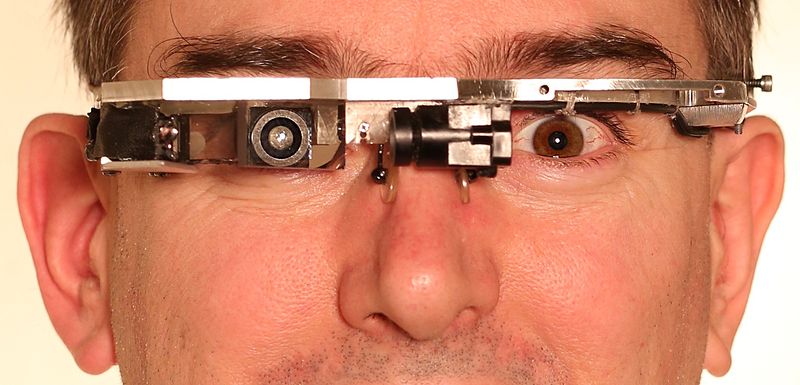
EyeTap (credit: Steve Mann)
UPDATE: McDonald’s provided this statement to KurzweilAI on July 18, 2012:
“We share the concern regarding Dr. Mann’s account of his July 1 visit to a McDonald’s in Paris. McDonald’s France was made aware of Dr. Mann’s complaints on July 16, and immediately launched a thorough investigation. The McDonald’s France team has contacted Dr. Mann and is awaiting further information from him.
In addition, several staff members involved have been interviewed individually, and all independently and consistently expressed that their interaction with Dr. Mann was polite and did not involve a physical altercation. Our crew members and restaurant security staff have informed us that they did not damage any of Mr. Mann’s personal possessions.
While we continue to learn more about the situation, we are hearing from customers who have questions about what happened. We urge everyone not to speculate or jump to conclusions before all the facts are known. Our goal is to provide a welcoming environment and stellar service to McDonald’s customers around the world.”
- McDonald’s
On July 1, Steve Mann, a professor of electrical and computer engineering at the University of Toronto and renowned as the world’s first cyborg, was physically assaulted in a McDonald’s in Paris for wearing his EyeTap eyeglass, with resulting damage to his eyeglass, which is surgically attached to his skull.
“I’m not seeking to be awarded money. I just want my Glass fixed,” said Steve. Paris police and McDonald’s were unresponsive, he said.
Maybe KurzweilAI readers in France and Europe can help? Here’s the McDonald’s contact page in France. We will pass along your comments and suggestions to Steve.
UPDATE: Khader Aissani, 36, manager, McDonald’s of Champs-Elysées as of Oct.2011:

Khader Aissani (credit: 20minutes.fr)
Here is Steve Mann’s report. It raises significant questions for future wearers of Google Glass and other enhancements.
Digital Eye Glass
I believe that Digital Eye Glass will ultimately replace glasses, and will help many people see better, and improve the quality of their lives through Augmediated Reality.
I wear a computer vision system, and carry a letter from my family physician, as well as documentation on this system when I travel.
I have worn a computer vision system of some kind for 34 years, and am the inventor of the technology that I wear and use in my day-to-day life.
Although it has varied over the last 34 years, I have worn the present embodiment of this system (pictured below) for 13 years. This simple design which I did in collaboration with designer Chris Aimone, consists of a sleek strip of aluminum that runs across the forehead, with two silicone nose pads. It holds an EyeTap device (computer-controlled laser light source that causes the eye itself to function as if it were both a camera and display, in effect) in front of my right eye. It also gives the wearer the appearance of having a “glass eye”, this phenomenon being known as the “glass eye” effect (Presence Connect, 2002).
Over the years the EyeTap has also therefore been known as the “Glass Eye” or “Eye Glass”, or “Digital Eye Glass”, using the word “Glass” in its singular form, rather than its plural form “Glasses” (See figure caption, “EyeTap digital eye glass”, Aaron Harris/Canadian Press, Monday Dec. 22, 2003).
Recent news has described me as “the father of wearable computing” in the context of various commercially manufactured versions of similar eye glass, such as those made by companies like Google, Olympus, and the like (see below), so as this technology becomes mainstream, McDonald’s might need to get used to it.
I originally created this technology, and the computer vision algorithms (e.g. HDR = High Dynamic Range), to help people see better. I have also assisted a number of blind and visually impaired (partially sighted) persons with various projects, and I continue to conduct research in this area. I was also part of the team that invented, designed, and built rehabilitation technology for the Canadian National Institute for the Blind, and this technology continues to be used by the CNIB.
Physical assault and willful destruction of customer’s property by persons acting as representatives of McDonald’s
In June of 2012, my wife, children, and I traveled to Paris, France, for our summer vacation, in order to give our children the opportunity to learn true Parisian French (we have them enrolled in French immersion at school).
On the evening of 2012 July 1st, my wife and children and I went to McDonalds at 140, Avenue Champs Elysees, Paris, France, after a day of sightseeing (8 museums and other landmark sights, as part of a boat cruise package), and while we were standing in line at McDonalds, I was stopped by a person who subsequently stated that he was a McDonalds employee, and he asked about my eyeglass (digital computer vision system, i.e. EyeTap).
Because we’d spent the day going to various museums and historical landmark sites guarded by military and police, I had brought with me the letter from my doctor regarding my computer vision eyeglass, along with documentation, etc., although I’d not needed to present any of this at any of the other places I visited (McDonald’s was the only establishement that seemed to have any problem with my eyeglass during our entire 2 week trip).
Since I happened to have it with me, I showed this doctor’s letter and the documentation to the purported McDonalds employee who had stopped me in the McDonalds line.
After reviewing the documentation, the purported McDonalds employee accepted me (and my family) as a customer, and left us to place our order. In what follows, I will refer to this person as “Possible Witness 1″.
We ordered two Ranch Wraps, one burger, and one mango McFlurry, from a cashier who I will refer to as “Possible Witness 2″. My daughter handled the cash to pay Possible Witness 2, as my daughter wanted to practice her French. Possible Witness 2 complimented my daughter on her fluency in French.
Next my family and I seated ourselves in the restaurant right by the entrance, so we could watch people walking along Avenue Champs Elysees while we ate our meal.
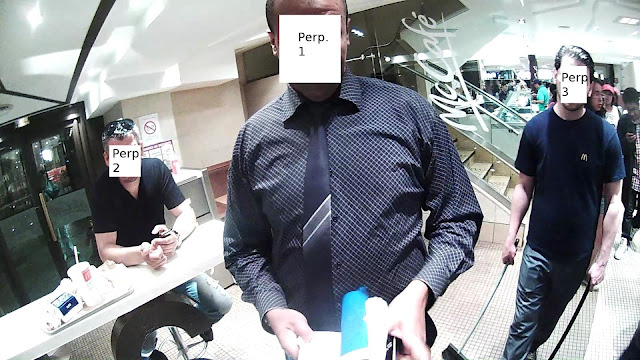
Left-to-right: Perpetrator 2, Perpetrator 1, and Perpetrator 3 (credit: Steve Mann)
Subsequently another person within McDonalds physically assaulted me, while I was in McDonand’s, eating my McDonand’s Ranch Wrap that I had just purchased at this McDonald’s. He angrily grabbed my eyeglass, and tried to pull it off my head. The eyeglass is permanently attached and does not come off my skull without special tools.
I tried to calm him down and I showed him the letter from my doctor and the documentation I had brought with me. He (who I will refer to as Perpetrator 1) then brought me to two other persons.
He was standing in the middle, right in front of me, and there was another person to my left seated at a table (who I will refer to as Perpetrator 2), and a third person to my right. The third person (who I will refer to as Perpetrator 3) was holding a broom and dustpan, and wearing a shirt with a McDonald’s logo on it. The person in the center (Perpetrator 1) handed the materials I had given him to the person to my left (Perpetrator 2), while the three of them reviewed my doctor’s letter and the documentation.

Left-to-right: Perpetrator 2 tearing up my doctor’s letter, while Perpetrator 3 watches (credit: Steve Mann)
After all three of them reviewed this material, and deliberated on it for some time, Perpetrator 2 angrily crumpled and ripped up the letter from my doctor. My other documentation was also destroyed by Perpetrator 1.
I noticed that Perpetrator 1 was wearing a name tag clipped to his belt. When I looked down at it, he quickly covered it up with his hand, and pulled it off and turned it around so that it was facing inwards, so that only the blank white backside of it was then facing outwards.
Perpetrator 1 pushed me out the door, onto the street.
The computerized eyeglass processes imagery using Augmediated Reality, in order to help the wearer see better, and when the computer is damaged, e.g. by falling and hitting the ground (or by a physical assault), buffered pictures for processing remain in its memory, and are not overwritten with new ones by the then non-functioning computer vision system.
As a result of Perpetrator 1′s actions, therefore images that would not have otherwise been captured were captured. Therefore by damaging the Eye Glass, Perpetrator 1 photographed himself and others within McDonalds.
The images, all taken by Perpetrator 1 (i.e. their having been captured was caused by Perpetrator 1′s actions), were among those recovered from the damaged computer vision system, and will hopefully help in solving this crime.
Please help
I tried on many occasions to contact McDonald’s but have not received any response. As McDonand’s does not publish any direct contact email information, I used the whois database to find some email addresses, e.g. of domains like “mcdonalds.com” and emailed those addresses.
My attempts included filling out various online forms on mcdonalds.com but to no avail. I also tried calling the main number, at mcdonands.com: 1-800-244-6227, but got a voice recording that was totally unintelligible (very loud and distorted), and it appears this number does not work.
I also contacted the Embassy, Consulate, Police, etc., without much luck.
In my research, I came across Penny Sheldon, a travel agent from Boise, Id., who was physically assaulted by McDonalds staff in Paris, France, because she photographed their menu. This seems surprising because many people use a handheld camera as a seeing aid to magnify and read signs, etc. (zooming into a picture to see it on screen).
Penny Sheldon contacted the Police in Paris, but did not receive much help from them. I’m not seeking to be awarded money. I just want my Glass fixed, and it would also be nice if McDonald’s would see fit to support vision research.
I don’t have the resources to take on a branch of a large multi-national corporation operating in a distant country, but I could use some help and advice as to how to resolve this matter, how to ensure it doesn’t happen again to me or anyone else wearing Eye Glass, and what can be done to advance Digital Eye Glass research in not just the technological realm, but also the realm of social responsibility and “culture and technology.
Best regards,
Steve
Dr. Steve Mann, PhD (MIT ’97), PEng (Ontario),
330 Dundas Street West
Toronto, Ontario,
Canada, M5T 1G5.
Research in Wearable Computing and Augmediated Reality
The more people that adopt this technology to improve the quality of their lives, the more that McDonald’s will become accustomed to it. You can become involved by building your own wearable computer vision system. See for example, the following links:
http://www.eyetap.org/publications/
Backside Project – начать и кончить с 20-25%
Сегодня я расскажу вам о новых результатах Backside Project. По-настоящему интересных, хотя и носящих предварительный характер. Тем, кому нехорошо от одного словосочетания “анальный секс”, дальше лучше не читать, да и тем, у кого сейчас рядом нервные родители/начальство/маленькие дети – тоже не стоит, будет одна не очень приличная картинка.
Напомню о том, что же такое Backside Project. Больше года назад у меня возникла мысль о том, что всякие сексуальные практики людей могли бы быть прекрасным примером того, насколько наш мозг пластичен и насколько он способен влиять не только на наши мысли, но и на наше тело. Секс является очень древним явлением, внутреннее оплодотворение возникло сотни миллионов лет назад, ключевую роль в сексуальном поведении играют структуры мозга, которые возникли еще до динозавров – а мы взяли и придумали нечто новое. Начали испытывать оргазм от странных и, казалось бы, довольно бессмысленных с эволюционной точки зрения вещей – иные мазохисты (а точнее bd-bottom, для тех, кто знает терминологию) уходят в некое особое состояние под названием subspace только от того, что их связали. Эротическое связывание, секс по переписке, порнография – человечество додумалось до многих весьма причудливых вещей и нельзя не задуматься о том, что еще может появится и каковы вообще пределы пластичности нашей сексуальности.
В мире, где буквально за сто лет поменялись репродуктивные стратегии и где впервые за всю историю вместо 6-7 детей стали рожать одного-двух, где продолжительность жизни выросла вдвое и где уже всерьез можно говорить даже о фактическом бессмертии – вопрос о пластичности сексуальности как минимум небезынтересен. А еще на эту тему довольно мало серьезных исследований, так что тут есть где развернуться.
В прошлом году я нашел совершенно уникальное явление. Пеггинг, он же страпон-секс. Суть в следующем:
Ни в “Истории проституции” Блоха, ни в книгах Мастерса и Джонсона “О любви и сексе”, ни в “Основах современной сексологии” Келли (1995 года выпуска) про это ничего не сказано. Про какую-нибудь там порку или, пардон, копролагнию, упоминали многие – а вот чтобы женщина взяла фаллос на ремешках (страпон, то есть) и вошла им в мужчину – это редкость, которая разве что в некоторых художественных произведениях упоминается. Редкость, извращение, и, по мнению многих, несусветная пакость.
Настали 1990-е, а потом XX век сменился XXI-м. Произошел бум – страпон-секс начали практиковать массово, про это начали говорить, это начали предлагать проститутки и соответствующие игрушки появились в каждом уважающем себя секс-шопе. Был придуман термин pegging для обозначения соответствующего акта и за несколько лет такое употребление слова стало более частым, чем в своем первоначальном значении (привязка курсов валют); мир поменялся и поменялся весьма, кхм, оригинальным образом. Почему?
В прошлом году я провел несколько анонимных опросов, обратившись как к двум имиджбордам (анонимные форумы, где упор сделан на обмен картинками; породили особую субкультуру. Пример: Двач), так и к специализированному форуму straponforum.ru (на момент набора этого текста не работал). Опросы, в которых приняло участие более ста человек, показали, что мужчины занимаются пеггингом (или хотели попробовать) по разным причинам – кому-то просто нравится на физиологическом уровне, кто-то воспринимает это как составную часть садомазохистких отношений, а кто-то хочет оказаться в роли женщины из интереса или даже потому, что втайне задумывается о собственной гендерной роли. Есть, естественно, и комбинации вариантов.
Выяснилось, что с гомосексуальными наклонностями пеггинг, по всей видимости, связан слабо или даже не связан вовсе. Геи, которых удалось опросить около нескольких десятков человек, отнеслись к пеггингу без энтузиазма, а вот среди тех, кто такой секс практикует, нашлось немало гетеросексуалов. Явление оказалось весьма сложным и на эту тему я уже писал – так что повторяться не буду. Перейду к новым данным.
Я обнаружил ряд свидетельств того, что при анальной стимуляции некоторые (но не все) мужчины испытывают оргазм, который выделяют отдельно – “анальный оргазм” отличается от обычного, причем как субъективно, так и на физиологическом уровне. Это какое-то не очень понятное явление, при котором, например, может не наблюдаться эрекции (примерно в половине случаев), но зато в ряде случаев такой оргазм может быть множественным – что для мужчин в общем-то весьма необычно. Я говорил про то, что наш мозг может перестраивать нашу физиологию – вот тому пример, неожиданный, но весьма наглядный.
Был проведен еще один небольшой опрос, где анонимным участникам предлагалось указать то, получали ли они оргазм от анальной стимуляции без воздействия на гениталии + время, которое потребовалось для формирования подобной способности. Результаты перед вами (картинка увеличится при нажатии):
Конечно, выборка маловата и надо бы больше (я работаю над этим). Но примечательно то, что она уже согласуется с данными прошлого года (в опросе был пункт о том, испытывал ли участник оргазм без стимуляции пениса) и, главное, с данными о женском оргазме. Что это значит – я расскажу в ближайшее время, следите за обновлениями.
V2V: Department of Transportation’s new communication system helps cars avoid crashes by talking to each other
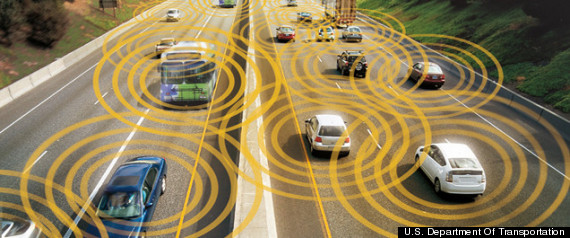
(Credit: U.S. Department of Transportation)
The University of Michigan is conducting a pilot program to test a vehicle-to-vehicle (V2V) communications device that could help drivers avoid accidents, CNET reports.
This technology could prevent up to 81 percent of all vehicle crashes, according to the Department of Transportation (DOT).
The school’s Transportation and Research Institute is seeking 3,000 drivers in the Ann Arbor, Mich., area, and will equip their vehicles with wireless equipment that will alert the drivers to vehicles moving erratically. Intersections will also be outfitted with communication devices, and eventually the system could facilitate “dynamic real-time timing of traffic signals.”
Last year the DOT announced that it will test consumer acceptance of V2V technology in six cities, including a 100-driver study in Brooklyn, Mich. The UM study, which is funded partly by the DOT, will focus on system reliability and consumer response to the service to figure out which alerts and types of communication are most effective.
Most drivers in the 3,000-person pilot program will have a V2V communications device installed in their existing vehicle, but 128 participants will get a new vehicle with this technology already integrated.
With V2V, more advanced versions of the systems can take control of a car to prevent an accident by applying brakes when the driver reacts too slowly to a warning, Huffington Post reports.
V2V “is our next evolutionary step … to make sure the crash never happens in the first place, which is, frankly, the best safety scenario we can all hope for,” said David Strickland, administrator of the National Highway Traffic Safety Administration. Overall, more than 32,000 people were killed in traffic accidents last year.
In addition to warning of cars running red lights or stop signs, “connected cars” can let drivers know if they don’t have time to make a left turn because of oncoming traffic. When driving on a two-lane road, the systems warn when passing is unsafe because of oncoming cars — even vehicles around a curve that the driver can’t see yet.
In a line of heavy traffic, the systems issue an alert if a car several vehicles ahead brakes hard even before the vehicle directly in front brakes. And the systems alert drivers when they’re at risk of rear-ending a slower-moving car.
It’s also possible for connected cars to exchange information with traffic lights, signs and roadways if states and communities decide to equip their transportation infrastructure with similar technology. The information would be relayed to traffic management centers, tipping them off to congestion, accidents or obstructions.
If cars are reported to be swerving in one spot on a roadway, for example, that could indicate a large pothole or obstruction. The constant stream of vehicle-to-infrastructure, or V2I, information could give traffic managers a better picture of traffic flows than they have today, enabling better timing of traffic signals to keep cars moving, for example. Correspondingly, cars could receive warnings on traffic tie-ups ahead and rerouting directions.
NHTSA has been working on the technology for the past decade along with eight automakers: Ford, General Motors, Honda, Hyundai-Kia, Mercedes-Benz, Nissan, Toyota and Volkswagen.
The technology is already available, said Rob Strassburger, vice president for safety of the Alliance of Automobile Manufacturers. He said what’s needed is for the government to set standards so that all automakers use compatible technology.
Since V2V relies on wireless technology, ensuring that the safety systems are reliable and can’t be hacked is another concern, NHTSA officials said.
The safety benefits of V2V won’t be fully realized until there is a critical mass of cars on the road that can talk to each other, and just where that point lies isn’t known. By the time the government sets standards and automakers are able to respond, it may be 10 years before the technology is widely available on new cars. It takes about 30 years for a new technology to work its way into the entire population of cars.
Some of the safety technologies for V2V are already available in cars, although they tend to be offered primarily on higher-end models. Lane departure systems, for example, warn drivers when their vehicle unintentionally wanders from its lane, and some can automatically steer the car back. Blind spot systems warn drivers of vehicles in adjacent lanes, and some can also steer away from hazards.
Forward collision warning systems alert drivers to impending crashes, and some can automatically brake if the driver doesn’t respond. Adaptive cruise control automatically adjusts vehicle speed to maintain a set distance from the car ahead in the same lane. Adaptive headlights change their aim in conjunction with the steering wheel. Parking sensors and rear-mounted cameras help a driver parallel park without scraping paint, bumping fenders or hitting pedestrians.
A key difference is that most of the current technologies rely on radar or laser sensors to “see” other nearby vehicles. They can’t warn drivers about cars they can’t see, such as the car that ran the red light in the intersection demonstration, or an oncoming car around a curve in the road.
Together, the currently available technologies and the future V2V systems may effectively form a kind of autopilot for the road. Said Strassburger: “The long-term trajectory for these technologies is the vehicle that drives itself — the driverless car.”
The Huffington Post article mentions the Safe Road Trains for the Environment (SARTRE) program in the “Future Cars” photo gallery at the bottom. SARTRE was featured recently on KurzweilAI (Volvo’s autonomous cars travel 124 miles in Spain in ‘road train’). Volvo Car Corporation spokesperson Jonas Ekmark offered these updates:
Q: Can a Volvo car be converted to work in a road train?
A: The research road train is to a large extent built of components that are in production with 2012 Volvos. Radar, computer vision, and laser sensors are already there, as well as controllable steering, brakes, and powertrain. Additional systems are likely to go into production and become affordable in the next coming years, for instance the V2V communication. However, it is likely that a road-train system needs to be built in to the car from the beginning in order to fulfill stringent vehicle-level requirements.
Q: How does the SARTRE project compare with Google’s autonomous cars?
“Our road train is led by a human driver in the first vehicle. The driver is responsible for all the followers during platooning, just like a bus driver or an airline pilot is reponsible for the passengers. So the following vehicles do not not make their own decisions, essentially.
“It is really cool to be in the middle of this active safety/autonomous driving revolution. In not too many years, we will have cars that drive by themselves, that avoid accidents, that consume much less energy, and that open up new ways of using your time productively.”
Tom Robinson, Project Director for Intelligent Transport Systems at Ricardo, which is developing the autonomous control systems for SARTRE, adds: “I would see the road train as also being supplementary to the rollout of autonomous vehicles; the platooning function and strategies can still be applied (to added benefit) once you have vehicle-to-vehicle cooperation.”
































































